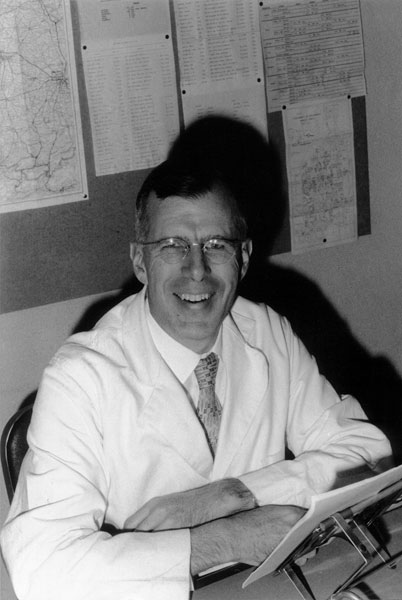Joseph T. Gregory (1914-2007)
Sixth director of UCMP
By Sarah Boyer1
I came to Berkeley with a keen interest in the history of science. During the application process, I wrote all of the usual letters to professors who shared my interests, and so made contact with Dr. Joseph T. Gregory, a Professor Emeritus who had taught courses in the history of paleontology. He responded with a letter and an entire packet of information, and I appreciated both the time he took on my behalf and his thoughtfulness. I was delighted to be asked to interview him for this article, part of theUCMP News series on the history of the museum’s directorship [Note: the series ended before the newsletter went online in September 1999]. I found him every bit as courteous, respectful, and gracious as he had seemed on paper. ‘Tell me about your history with the Museum,’ I began, and he proceeded to narrate a story which goes back nearly 70 years.

Joseph Gregory came to Berkeley in 1931. As an undergraduate at Berkeley, he took an introductory paleontology class from Professors Charles Camp and Ralph Chaney which inspired him to turn his youthful interest in vertebrate paleontology into what would prove to be a long and distinguished career.
During his undergraduate years, Gregory did field work with Charles Camp in the Triassic of Arizona and New Mexico. As a Berkeley graduate student under Dr. Ruben Stirton (Museum Director, 1950-1966), he concentrated on fossil mammals in South Dakota.
Gregory briefly moved east to the American Museum of Natural History and Columbia University as a postdoctoral student, joining in the Museum’s 1939 field season. Once this work was completed, he took a job at the University of Texas where he collected vertebrates all over the state. He was also in charge of a lab project that was part of the WPA (Works Progress Administration), a program providing work for a large number of people during the 1930s and World War II. One of his WPA work crews found a Triassic reptile, Trilophosaurus, which caught Gregory’s interest and actually led to a year-long position at the University of Michigan as the successor of the man who had first described the species in 1941, Dr. E.C. Case.
Gregory served in the army during World War II. When he returned, he taught at the University of Michigan’s summer field camp before heading to Yale, where he concentrated on the Triassic of New Mexico and Texas for several years.
In 1960, Gregory came home to the Department and Museum of Paleontology at Berkeley. Initially a professor and curator, he became Director in 1971. The chief event of Gregory’s directorship was the negotiation for the Blackhawk Ranch fossil locality. The quarry on this land contains a rich mammal fauna which had been of interest to Berkeley paleontologists since the 1930s. Courses in paleontology had included field trips there regularly from 1950 to 1980 and when the ranch went up for sale in 1971, Gregory initiated talks with the Blackhawk Corporation, which was buying the land. He gained permission to continue trips to the locality and was instrumental in the eventual donation to UCMP of a small tract of land surrounding the quarry.
Gregory initially spent much effort as Director trying to smooth over departmental feuding, which had been fierce during the 1950s and into the 1960s. This friction eventually eased by the 1970s. During the 1960s, Gregory continued to work on Triassic reptiles and amphibians in New Mexico, and also became interested in the history of paleontology and published a number of papers on the subject. Another new interest cropped up in 1973, when Professor Mike Murphy at UC Riverside found some placoderm fishes in the Devonian of central Nevada. Gregory, Murphy, Tom Morgan, and John Reed made a successful collection from the area, a project which continued into the 1980s.
Joseph Gregory taught in the Department of Paleontology until 1979, when he retired and became a Professor Emeritus. He has continued his work on the history of paleontology, and is especially interested in the history of Berkeley’s Department and Museum of Paleontology, to which he has made a long-term and substantial contribution. Part of his continuing work includes this series of UCMP News articles on past Museum Directors. With the modesty that seems to characterize his personality, he turned the task of writing about his career to another writer, but he will resume his installments in the next issue.
About seven years after Sarah Boyer wrote the above article, Joe Gregory passed away at the age of 93. A more detailed account of Joe’s life and accomplishments appeared in the January 2008 UCMP News newsletter.